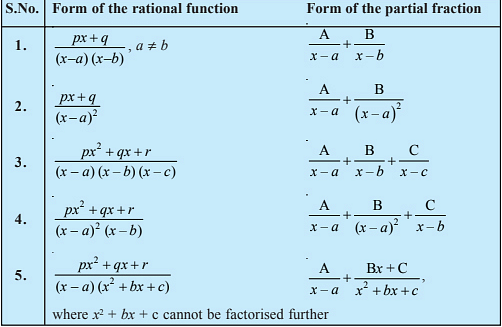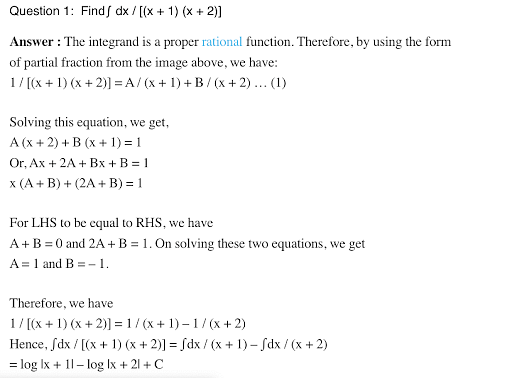Integrate the rational function: \(\frac{x}{(x+1)(x+2)}\)
Solution and Explanation
Let \(\frac{x}{(x+1)(x-+2)} = \frac{A}{(x+1)}+\frac{B}{(x+2)}\)
\(\Rightarrow x = A(x+2)+B(x+1)\)
Equating the coefficients of x and constant term, we obtain
A + B = 1
2A + B = 0
On solving, we obtain
A = −1 and B = 2
∴ \(\frac{x}{(x+1)(x+2)}=\frac{-1}{(x+1)}+\frac{2}{(x+2)}\)
\(\Rightarrow \int \frac{x}{(x+1)(x+2)}dx = \int \frac{-1}{(x+1)}+\frac{2}{(x+2)}dx\)
= \(- \log \mid x+1 \mid +2\log \mid x+2 \mid+C\)
= \(\log(x+2)^2 -\log \mid x+1 \mid+C\)
= \(\log(\frac{x+2)^2}{ (x+1)}+C\)
Top Questions on integral
Let \( f : (0, \infty) \to \mathbb{R} \) be a twice differentiable function. If for some \( a \neq 0 \), } \[ \int_0^a f(x) \, dx = f(a), \quad f(1) = 1, \quad f(16) = \frac{1}{8}, \quad \text{then } 16 - f^{-1}\left( \frac{1}{16} \right) \text{ is equal to:}\]
- Let $ f(x) $ be a positive function and $I_1 = \int_{-\frac{1}{2}}^1 2x \, f\left(2x(1-2x)\right) dx$ and $I_2 = \int_{-1}^2 f\left(x(1-x)\right) dx.$ Then the value of $\frac{I_2}{I_1}$ is equal to ____
- The value of the definite integral \( \int_0^{\pi} \sin^2 x \, dx \) is:
- Evaluate the integral: \[ \int \frac{\sin(2x)}{\sin(x)} \, dx \]
- Find the value of the integral: \[ \int_0^\pi \sin^2(x) \, dx. \]
Questions Asked in CBSE CLASS XII exam
- If \( \vec{\alpha} = \hat{i} - 4 \hat{j} + 9 \hat{k} \) and \( \vec{\beta} = 2\hat{i} - \hat{j} + \lambda \hat{k} \) are two mutually parallel vectors, then \( \lambda \) is equal to:
"There is widely spatial variation in different sectors of work participation in India." Evaluate the statement with suitable examples.
- CBSE CLASS XII - 2025
- Population
Alexia Limited invited applications for issuing 1,00,000 equity shares of ₹ 10 each at premium of ₹ 10 per share.
The amount was payable as follows:- On application ₹ 9 per share (Including premium ₹ 6 per share)
- On allotment ₹ 8 per share (Including premium ₹ 4 per share)
- On first and final call ₹ 3 per share.
Applications were received for 1,50,000 equity shares and allotment was made to the applicants as follows:
Category A: Applicants for 90,000 shares were allotted 70,000 shares.
Category B: Applicants for 60,000 shares were allotted 30,000 shares.
Excess money received on application was adjusted towards allotment and first and final call.
Shekhar, who had applied for 1200 shares failed to pay the first and final call. Shekhar belonged to category B.
Pass necessary journal entries for the above transactions in the books of Alexia Limited. Open calls in arrears and calls in advance account, wherever necessary.- Shweta mixed two liquids A and B of 10 mL each. After mixing, the volume of the solution was found to be 20.2 mL.
(i) Why was there a volume change after mixing the liquids?
(ii) Will there be an increase or decrease of temperature after mixing?
(iii) Give one example for this type of solution.- CBSE CLASS XII - 2025
- Solutions
On $31^{\text {st }}$ March, 2024, following is the Balance Sheet of Bhavik Limited :
Bhavik Ltd.
Balance Sheet as at $31^{\text {st }}$ March 2024
I. Equity and Liabilities :
Particulars Note No. $31-3-2024$ (₹) $31-3-2023$ (₹) 1. Shareholders funds (a) Share Capital 12,00,000 10,00,000 (b) Reserves and Surplus 1 4,00,000 3,00,000 2. Non-current liabilities Long-term borrowings 2 6,00,000 10,00,000 3. Current Liabilities 5,00,000 1,00,000 (a) Trade Payables 3 3,00,000 4,00,000 (b) Short-term provisions Total 30,00,000 28,00,000 II. Assets :
1. Non-current Assets (a) Property, Plant and Equipment and Intangible Assets Property plant and equipment 4 19,00,000 15,00,000 (b) Non-current Investments 3,00,000 4,00,000 2. Current Assets (a) Inventories 4,50,000 3,50,000 (b) Trade Receivables 2,50,000 4,50,000 (c) Cash and Cash Equivalents 1,00,000 1,00,000 Total 30,00,000 28,00,000 Notes to Accounts :
Note Particulars $31-3-2024$ (₹) $31-3-2023$ (₹) No. 1. Reserves and Surplus i.e. Balance in Statement of Profit and Loss 4,00,000 3,00,000 2. Long-term borrowings 10% Debentures 6,00,000 10,00,000 3. Short-term provisions Provision for tax 3,00,000 4,00,000 4. Property plant and equipment Plant and Machinery 21,50,000 16,00,000 Less : Accumulated Depreciation 2,50,000 1,00,000 19,00,000 15,00,000 Additional Information :
- During the year, a piece of machinery costing ₹ 8,00,000 with accumulated depreciation of ₹ 50,000 was sold for ₹ 6,50,000.
- Debentures were redeemed on $31^{\text {st }}$ March, 2024.
Calculate :
- Cash flows from Investing Activities
- Cash flows from Financing Activities
- CBSE CLASS XII - 2025
- Balance sheet statement
Concepts Used:
Integration by Partial Fractions
The number of formulas used to decompose the given improper rational functions is given below. By using the given expressions, we can quickly write the integrand as a sum of proper rational functions.

For examples,
